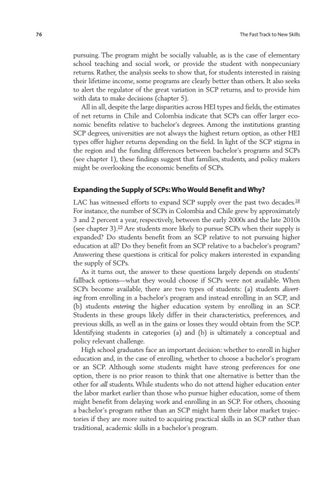76
The Fast Track to New Skills
pursuing. The program might be socially valuable, as is the case of elementary school teaching and social work, or provide the student with nonpecuniary returns. Rather, the analysis seeks to show that, for students interested in raising their lifetime income, some programs are clearly better than others. It also seeks to alert the regulator of the great variation in SCP returns, and to provide him with data to make decisions (chapter 5). All in all, despite the large disparities across HEI types and fields, the estimates of net returns in Chile and Colombia indicate that SCPs can offer larger economic benefits relative to bachelor’s degrees. Among the institutions granting SCP degrees, universities are not always the highest return option, as other HEI types offer higher returns depending on the field. In light of the SCP stigma in the region and the funding differences between bachelor’s programs and SCPs (see chapter 1), these findings suggest that families, students, and policy makers might be overlooking the economic benefits of SCPs.
Expanding the Supply of SCPs: Who Would Benefit and Why? LAC has witnessed efforts to expand SCP supply over the past two decades.18 For instance, the number of SCPs in Colombia and Chile grew by approximately 3 and 2 percent a year, respectively, between the early 2000s and the late 2010s (see chapter 3).19 Are students more likely to pursue SCPs when their supply is expanded? Do students benefit from an SCP relative to not pursuing higher education at all? Do they benefit from an SCP relative to a bachelor’s program? Answering these questions is critical for policy makers interested in expanding the supply of SCPs. As it turns out, the answer to these questions largely depends on students’ fallback options—what they would choose if SCPs were not available. When SCPs become available, there are two types of students: (a) students diverting from enrolling in a bachelor’s program and instead enrolling in an SCP, and (b) students entering the higher education system by enrolling in an SCP. Students in these groups likely differ in their characteristics, preferences, and previous skills, as well as in the gains or losses they would obtain from the SCP. Identifying students in categories (a) and (b) is ultimately a conceptual and policy relevant challenge. High school graduates face an important decision: whether to enroll in higher education and, in the case of enrolling, whether to choose a bachelor’s program or an SCP. Although some students might have strong preferences for one option, there is no prior reason to think that one alternative is better than the other for all students. While students who do not attend higher education enter the labor market earlier than those who pursue higher education, some of them might benefit from delaying work and enrolling in an SCP. For others, choosing a bachelor’s program rather than an SCP might harm their labor market trajectories if they are more suited to acquiring practical skills in an SCP rather than traditional, academic skills in a bachelor’s program.

